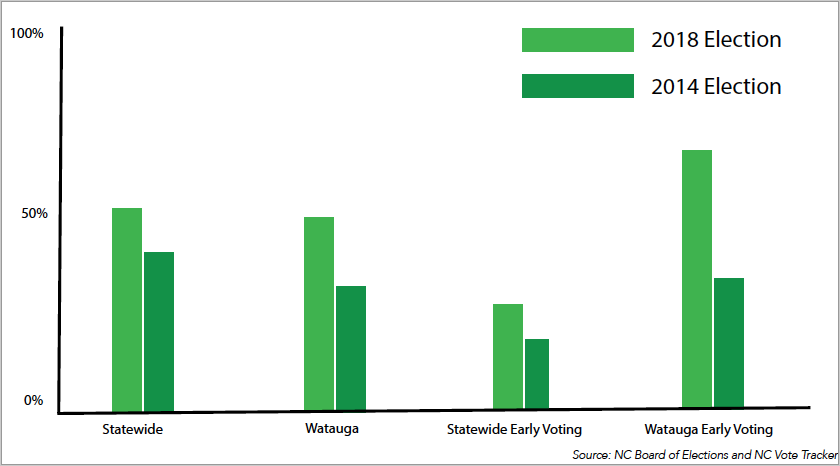The 2018 election midterms have come to an end. Some national elections are still too close to call, but Watauga County has counted all of its votes. Some surprising and not so surprising results came out of the election in Watauga County.
Voter turnout
In North Carolina, voter turnout for a midterm election was up from 2014. Out of the 7,089,657 people able to cast ballots, 3,713,703 ballots were actually cast, compared to 2014 when only 44.35 percent of people voted. This year it was up to 52.38 percent.
Breaking it down even further to Watauga County, in 2014 37.57 percent of the population voted while in the 2018 midterm election, 51.21 percent of the population voted.
Early voting played a big role this election cycle. In 2014, 18 percent of the registered voters voted early while 2018 saw 29 percent of voters voting early, according to the News and Observer. Watauga County had 15,766 early voters in 2018 compared to 7,865, according to ncvotetracker.com, a project of the Civitas Institute.
Watauga goes blue
Watauga County had some surprising results in this election as one incumbent lost and DD Adams made a strong impression. Ray Russell defeated incumbent Jonathan Jordan for the House of Representatives 93rd District. Russell won with 52.04 percent of the vote even though Jordan had been in office since 2010.
Russell is a familiar face for App State students but he isn’t the only person with App State connections who was elected to office. Charlie Wallin, who is the assistant director of food services for catering at App State, was elected to Watauga County Board of Commissioners District 5 seat.
Virginia Foxx defeated DD Adams, but Adams received more of the vote than many expected. In the 2014 midterm, Foxx lost Watauga County by two votes. In 2018, she lost it by 2,986 votes. According to the Winston Salem Journal, Adams gave Foxx her strongest challenge since 2012 when Elisabeth Motsinger got 42.5 percent of the vote.
While Foxx and Deanna Ballard won the district vote, every single Democrat on the ballot won in Watauga County. The only two Republicans who won in the county were running unopposed (Seth Banks, District Attorney General, and Gary Gavenus, District 24 court judge).
Blue wave? Kind of.
A blue wave of Democrat voters was anticipated by many. Was there a blue wave? Yes and no. It wasn’t a wave big enough to surf, but one to float over with little effort.
In North Carolina, Democrats broke the GOP supermajority in the General Assembly. This means if Governor Roy Cooper vetoes something it stays vetoed. North Carolina also voted down two amendments, Nonpartisan Judicial Merit Commission and the Bipartisan Board of Ethics and Elections. Those two amendments would have shifted the power from the governor to lawmakers.
Nationally, the blue wave was felt in the house. Democrats won back control of the house with more races still being counted.
Republicans retained control of the Senate and, as of this article, have two more too close to call races with Republicans in a slight lead. In Texas, Democrat Beto O’Rourke faced off against Republican incumbent Ted Cruz. O’Rourke lost with only 48.3 percent of the vote. O’Rourke may have lost, but he put up good numbers as a progressive in a red state.
There are now 23 Democrat governors with a notable upset in Wisconsin where Republican incumbent Scott Walker lost to Democrat Tony Evers. The Georgia and Florida governor races were closely watched and are still very close. In Georgia, Republican Brian Kemp leads Stacey Abrams with 50.3 percent of the vote while Republican Ron DeSantis is leading Andrew Gillum with 49.7 percent of the vote.
It may not have been as big of a blue wave as some expected, but there was still a high turnout for Democrats this election. Democrats will look to keep their momentum into 2020 while Republicans will look to try and win back the house in 2020 and the keep the presidency.
Story by Moss Brennan
Graphic by Moss Brennan


